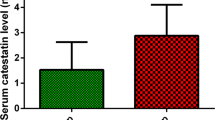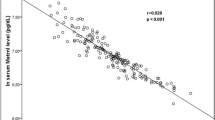Abstract
Background
Obstructive sleep apnea syndrome (OSAS) is associated with increased rates of cardiovascular diseases (CVD). The basic mechanisms involved in the increased cardiovascular risk of OSAS remain unclear. Recent discoveries of fat-secreted substances which serve endocrine roles improve our understanding of the relationship between OSAS, CVD, and the metabolic syndrome. In this study, we aimed to examine associations between omentin levels and OSA.
Methods
Forty-six newly diagnosed OSA patients and 35 non-apneic controls were enrolled in this study. Demographical data, cigarette smoking status, previous history of chronic diseases including CVD and metabolic diseases and drugs, and habits were obtained using a standardized questionnaire. All patients underwent polysomnographic evaluation. Omentin was measured the following morning.
Results
The mean age was 48.1 ± 12.5 (24–74) years in the OSA group and 42.8 ± 14.1 (21–69) years in the control group. Of the 81 patients, 46 (34 males and 12 females) were classified as having OSA and 35 patients (20 males and 15 females) as control. Plasma levels of omentin were found to be markedly higher in OSA patients (570.8 ng/ml) than in the control group (432.0 ng/ml; p < 0.001). In addition, plasma levels of omentin were found to be high in all OSA subgroups than in controls. The plasma omentin levels were significantly correlated only with age in patients with OSA.
Conclusions
We conclude that circulating omentin levels are elevated in OSA patients. To the best of our knowledge, this is the first clinical study that demonstrated the association between omentin and OSA.

Similar content being viewed by others
References
Young T, Palta M, Dempsey J, Skatrud J, Weber S, Badr S (1993) The occurrence of sleep-disordered breathing among middle-aged adults. N Engl J Med 328(17):1230–1235
McNicholas WT, Bonsigore MR (2007) Sleep apnoea as an independent risk factor for cardiovascular disease: current evidence, basic mechanisms and research priorities. Eur Respir J 29:156–178
Shetty GK, Economides PA, Horton ES, Mantzoros CS, Veves A (2004) Circulating adiponectin and resistin levels in relation to metabolic factors, inflammatory markers, and vascular reactivity in diabetic patients and subjects at risk for diabetes. Diabetes Care 27(10):2450–2457
El Solh AA, Akinnusi ME, Baddoura FH, Mankowski CR (2007) Endothelial cell apoptosis in obstructive sleep apnea: a link to endothelial dysfunction. Am J Respir Crit Care Med 175(11):1186–1191
Jelic S, Padeletti M, Kawut SM, Higgins C, Canfield SM, Onat D, Colombo PC, Basner RC, Factor P, LeJemtel TH (2008) Inflammation, oxidative stress, and repair capacity of the vascular endothelium in obstructive sleep apnea. Circulation 117(17):2270–2278
Kershaw EE, Flier JS (2004) Adipose tissue as an endocrine organ. J Clin Endocrinol Metab 89(6):2548–2556
Moreno-Navarrete JM, Ortega F, Castro A, Sabater M, Ricart W, Fernandez-Real JM (2011) Circulating omentin as a novel biomarker of endothelial dysfunction. Obesity (Silver Spring) 19(8):1552–1559
Tan BK, Adya R, Randeva HS (2010) Omentin: a novel link between inflammation, diabesity, and cardiovascular disease. Trends Cardiovasc Med 20(5):143–148
Iber C, Ancoli-Israel S, Chesson AL, Quan SF (2007) The AASM manual for the scoring of sleep and associated events: rules, terminology, and technical specifications. AASM, Westchester
Ryan S, Taylor CT, McNicholas WT (2009) Systemic inflammation: a key factor in the pathogenesis of cardiovascular complications in obstructive sleep apnoea syndrome? Thorax 64(7):631–636
Liu R, Wang X, Bu P (2011) Omentin-1 is associated with carotid atherosclerosis in patients with metabolic syndrome. Diabetes Res Clin Pract 93(1):21–25
Bergmann K, Sypniewska G (2013) Diabetes as a complication of adipose tissue dysfunction. Is there a role for potential new biomarkers? Clin Chem Lab Med 51(1):177–185
Zhang XL, Yin KS, Wang H, Su S (2006) Serum adiponectin levels in adult male patients with obstructive sleep apnea hypopnea syndrome. Respiration 73(1):73–77
Vatansever E, Surmen-Gur E, Ursavas A, Karadag M (2011) Obstructive sleep apnea causes oxidative damage to plasma lipids and proteins and decreases adiponectin levels. Sleep Breath 15(3):275–282
Sharma SK, Kumpawat S, Goel A, Banga A, Ramakrishnan L, Chaturvedi P (2007) Obesity, and not obstructive sleep apnea, is responsible for metabolic abnormalities in a cohort with sleep-disordered breathing. Sleep Med 8(1):12–17
Makino S, Handa H, Suzukawa K, Fujiwara M, Nakamura M, Muraoka S, Takasago I, Tanaka Y, Hashimoto K, Sugimoto T (2006) Obstructive sleep apnoea syndrome, plasma adiponectin levels, and insulin resistance. Clin Endocrinol (Oxf) 64(1):12–19
Tauman R, Serpero LD, Capdevila OS, O'Brien LM, Goldbart AD, Kheirandish-Gozal L, Gozal D (2007) Adipokines in children with sleep disordered breathing. Sleep 30(4):443–449
Joo EY, Hong SB, Sohn YB, Kwak MJ, Kim SJ, Choi YO, Kim SW, Paik KH, Jin DK (2010) Plasma adiponectin level and sleep structures in children with Prader–Willi syndrome. J Sleep Res 19(1 Pt 2):248–254
Gozal D, Lipton AJ, Jones KL (2002) Circulating vascular endothelial growth factor levels in patients with obstructive sleep apnea. Sleep 25(1):59–65
Conflict of interest
This is not an industry-supported study. The authors have indicated no conflicts of interest.
Author information
Authors and Affiliations
Corresponding author
Rights and permissions
About this article
Cite this article
Kurt, O.K., Tosun, M., Alcelik, A. et al. Serum omentin levels in patients with obstructive sleep apnea. Sleep Breath 18, 391–395 (2014). https://doi.org/10.1007/s11325-013-0898-0
Received:
Revised:
Accepted:
Published:
Issue Date:
DOI: https://doi.org/10.1007/s11325-013-0898-0




